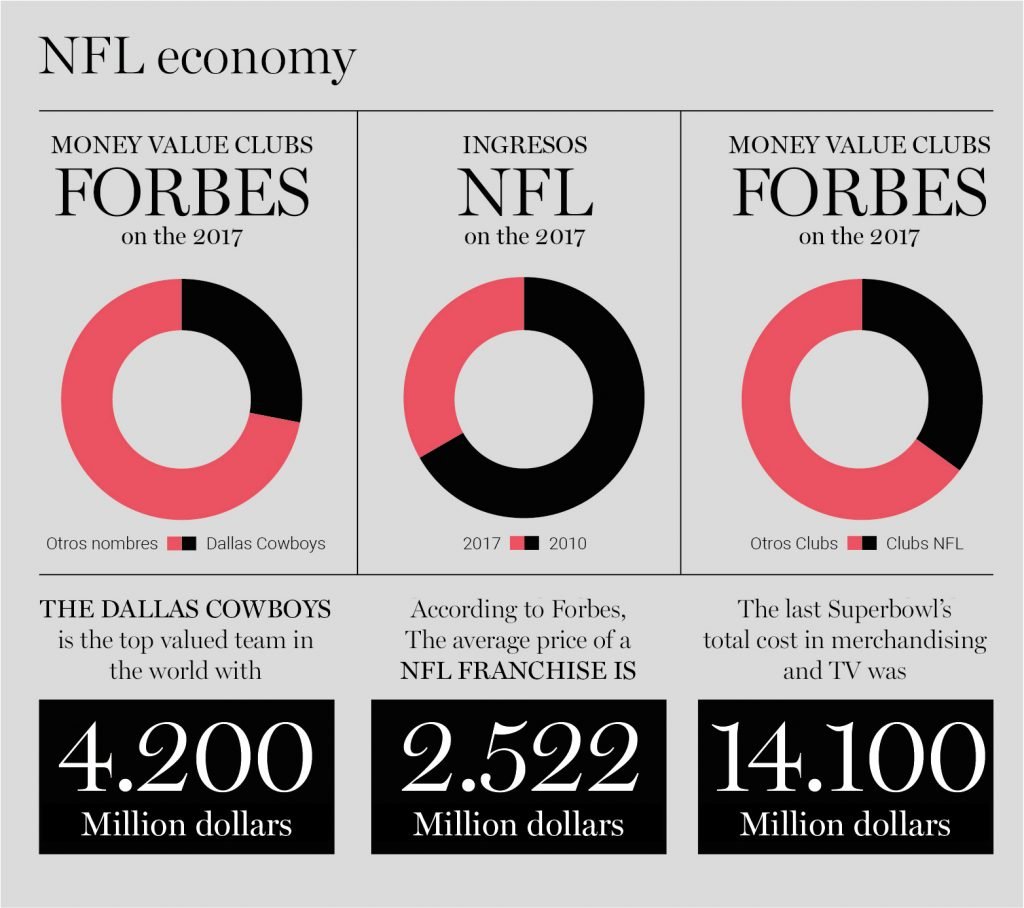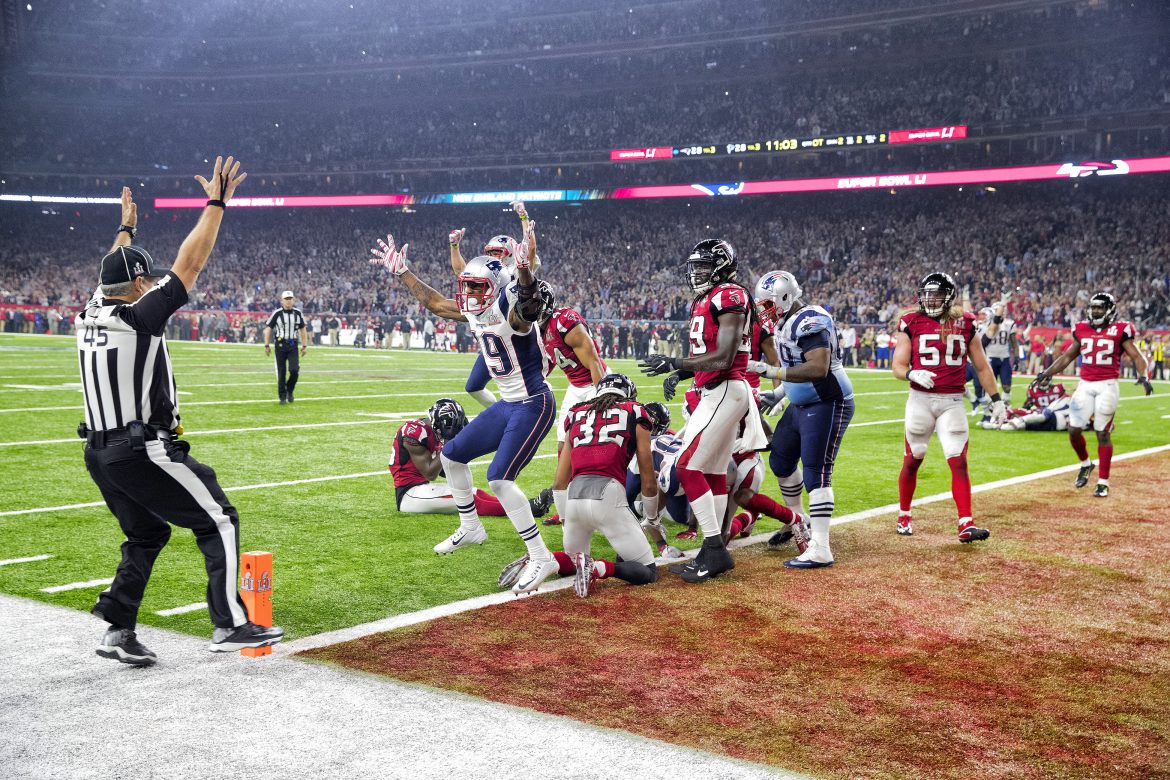[dropcap letter=”I”]
n all probability, when most people outside the USA think about American football, what comes to their mind is the latest million dollar commercial featuring Pepsi, Budweisser or Audi at the Superbowl, the unforgettable recent controversy over the ‘nipplegate’ when Justin Timberlake ripped off part of Janet Jackson’s costume, exposing one of her nipples on live tv, or even a striking image of a player tackling another player, played a thousand times in slow motion in some sports zapping tv programme.
But beyond record figures, iconic or controversial moments, American football and its National Football League (NFL) is also the top sports business in the world. This is a competition that lasts only five months, from September to January, and despite its clear attempts to go global, holds interest only in the USA. But despite this, last year the NFL generated a total revenue of $13,300 M and each of its 32 franchises or teams hold an average value of $2,522 M, according to Forbes. Or in other words, this revenue is higher than its next candidate on the list, the Major League Baseball (MLB) by $9,500 M per year. And well ahead -light years away from- the major soccer leagues, like the $4,865 M of the English Premier League and the $ 2,048 M of the Spanish LaLiga.
From a financial perspective, the term “king of sports” should go for American football, especially after checking that 10 of the highest valued sports clubs, according to Forbes, go to four NFL franchises including the Dallas Cowboys, spearheading the list with $4,200 M. At this point, it should be noted that the three major soccer clubs, Manchester United, FC Barcelona and Real Madrid, have a total revenue of arounds $3,600 M, but in terms of leagues, none of them gets even close to the figures handled by the 32 owners of the 32 leading franchises holding the NFL.
In an overview of the main European football teams, we could speculate with a great private league of clubs in Europe that could equal this massive sports goose laying the golden eggs, but reality tells that the current Champions League organized by the UEFA generates hardly half of the NFL revenue. In fact, ESPN journalist, Gabriele Marcotti, speculated in an excellent article with this hypothetical possibility and enumerates a whole list of reasons why, with the current Champion League format, European football can never dream of equalling the figures generated by American football, if both leagues ever stood face to face. Some of these reasons are the lower number of matches and shorter duration (which shortens the leeway to introduce tv commercials), a less compact and more heterogeneous audience and the feeling that, in the European Champions League, no matter what, the same teams will end up winning.
This is precisely one of the keys to the success of the NFL, the reason why it is such an appealing dish for any investment, its capacity to generate an engaging story that goes beyond sport itself. Like the title of the famous Oliver Stone and Al Pacino film, Any Given Sunday, anything and everything can happen on the field in American football.

This is a list of the top 10 features that make this league so unique and productive, which maybe our football should try to take into consideration, should it ever aim to equal its level.
- Salary cap. Saying that any Sunday anything and everything could happen is much more than a simple nice-sounding motto. The NFL is a private competition whose contenders have the same budget, have to offer the same amount of salary to its players and transfers do not cost money but are done in exchange of other players or having the upper hand in choosing future college athletes. Anyone can beat anyone, most matches are evenly matched and the final result is decided at the last seconds, and at the beginning of the season, the range of candidates to win the league is enormous. In a word, this competition is much fairer and all the football fans maintain intact their legitimate glory dreams.
- Draft. The squad’s line-up players, the roster, is massive and is made up of 53 official players. The origin of this large number of players is the NCAAF, the American College League, with each year the teams picking their best candidates in seven legs where each franchise picks a player per round. This is a process known as the Draft, which enables during post-season months to keep the competition flame alight, by analysing the potential of players from the best colleges. Despite that, the large number of players needed and their relatively short duration in the league (three years) makes that many professional players never get to play, and this has triggered all kinds of amazing personal growth stories. One example, the undisputedly best player of all times, Tom Brady, quarterback for the New England Patriots, was drafted in the sixth round with the 199th pick overall.
- Everythin counts. Everything that happens around the NFL is measured and positioned on a ranking or a graphic. The teams are divided into three big ‘platoons’ or blocks: offense, defence and special teams and they all are absolute specialists. In other words, the attack of a team is played against the defence of the other. The books on moves and strategies are countless and deciding any move involves taking into account a whole raft of factors. This involves measuring speed, distance, effectiveness and dozens of other variables for each position and move on the field. Despite its apparent complexity, the average football fan loves delving into this chess game of sorts, counting every snap or move and having as many facts and figures as they can in order to enjoy the game to the full.
- Everything can be heard. When comparing European football and American football, this is one of the silliest things. For the former, it is common to see the players cover their mouths with their hand when they are on the field to prevent anyone from knowing what they say or the clubs have built barricades to limit and control the access of information to football fans. Well, the NFL stands at the other end. During matches, you can hear the quarterback calling the moves or the referee addressing the audience through a microphone accounting for any decision or penalty announcements. Also, several players or other officials use mics while they play, and after the match some of the best comments are broadcast before, during or after the clash. And, needless to say, the clubs themselves disseminate videos showing the atmosphere of their celebrations or defeat from within the locker room, including the final words from the coach (locker room speech) after each match. All these contribute to bringing football fans closer to their team.
- Fantasy, a parallel sport. This is a concept that has been developing in Europe with sports such as football or basketball mainly, but the NFL has even equalled the nature of the sport itself. Fantasy is a virtual league that, depending on the individual actions of each player or team, gives a mark. The supporters choose their players and accumulate points on account of their performance. Now, this concept is so deeply rooted in the NFL that all broadcasts offer the players’ Fantasy rankings on a par with their actual performance. Any football fan plays a private league with their family, friends or workmates, and the expectations of winning your Fantasy competition engage you in the league to the very last match. There are sports programmes and webs dedicated exclusively to construct Fantasy rankings and professional line-ups involving large sums of money, similarly to what happens in online poker.
- Use of technology. Obviously, the level of NFL updating is extreme and nothing is left to chance. With commercial breaks and cuts, NFL matches are three hours long, apart from additional details, inside stories that help explaining the bigger picture at every match. The technological level of the broadcasting is incredible, with an unbelievable number of takes and camera angles, many of them essential for controversial ref decisions. Each figure or change of possession is monitored, recorded on video and replayed as it can be rectified, and any team has the option to review the video once each period. The margin error is minimal and, whenever errors or unfair decisions occur, the ensuing scandal triggers a quick change in the regulations.
- Mixture of tradition and business. American football is much more than a sport in the US. It has long overtaken baseball as the nation’s favourite entertainment and watching a football match live or on tv is almost a sacred institution. Its convenient time scheduled on Sundays guarantees a family occasion, with rounds of matches between 13 and 16 local time (the Asian market does not have a say in the time). On Thursday, Sunday and Monday night there are feature matches, and all the teams are allocated a featured schedule time at least once in the season. Everybody knows these are the days and times of the NFL match, and this is a tradition, while everybody knows that there are no NFL matches on Saturdays because this is the day chosen for college competitions. Local audiences have the upper hand, while at the same time try to maximize their benefits by forcing franchises to build stadiums with standard facilities for VIP rooms, restaurants, shops, etc, under threat of relocalising teams for more competitive commercial markets. For example, in the last two years, two franchises have landed in Los Angeles, and there will be shortly another franchise in Vegas.
- Globalisation. Unquestionably, the NFL is designed to attract and exploit local public interest. But this is a limitation that the NFL is not ready to accept. For some years now, the NFL has been making efforts to expand itself beyond the US boundaries. Apart from broadcasting for dozens of countries and elaborating featured contents in several languages, the NFL has taken to the extreme the idea that the best way to attract followers is making them live the same experience that local audiences get. This is why the NFL has opened up shop in Mexico and Great Britain, its two main markets, and every year several official matches are played each season. Visits of foreign teams are distributed and broadcast in such a way that all international fans can see, sooner or later, their favourite teams and players. Next year, it is estimated that four matches will be played in London and one of them will be played in Mexico DF.
- An audiovisual universe. Such capacity to generate news, stories, facts and figures requires an enormously powerful communicative backup, and obviously, the NFL takes special care of that. Beyond the countless amount of media coverage, the NFL has its own tv channel called NFL Network, available to large audiences like any other pay tv channel. NFL Network produces all types of competition-related content: reviews, debates, analyses, historic matches, etc… It also features a real-time carousel that gives coverage to simultaneously played matches on Sundays. Apart from this TV channel, NFL Films has been producing since the 1960s cinema-quality feature documentaries on the NFL universe.
- Unlimited growth. This blend of emotions, dreams, fears and surprises is the best-selling feature of the NFL, as it manages to build a whole world that enables monetising like no other business. In the last four years, Roger Goodell, NFL Commissioner contracted directly by the 32 owners of the NFL teams, earned $145 M, $65 M over the NFL’s best-paid player. What does Goodell’s job consist in? Making the amount of money divided by the 32 teams grow each year. The franchises split evenly the revenue generated by TV contracts (the biggest slice of the NFL cake), sponsoring, licences and merchandising. Last year, this amounted to $7,800 M. The 2027 forecast indicates that the NFL will generate $25,000 M, approximately half of which will be pocketed by the owners of the 32 franchises. The golden rule is clear: what is good for sports is good for business. And viceversa.




















